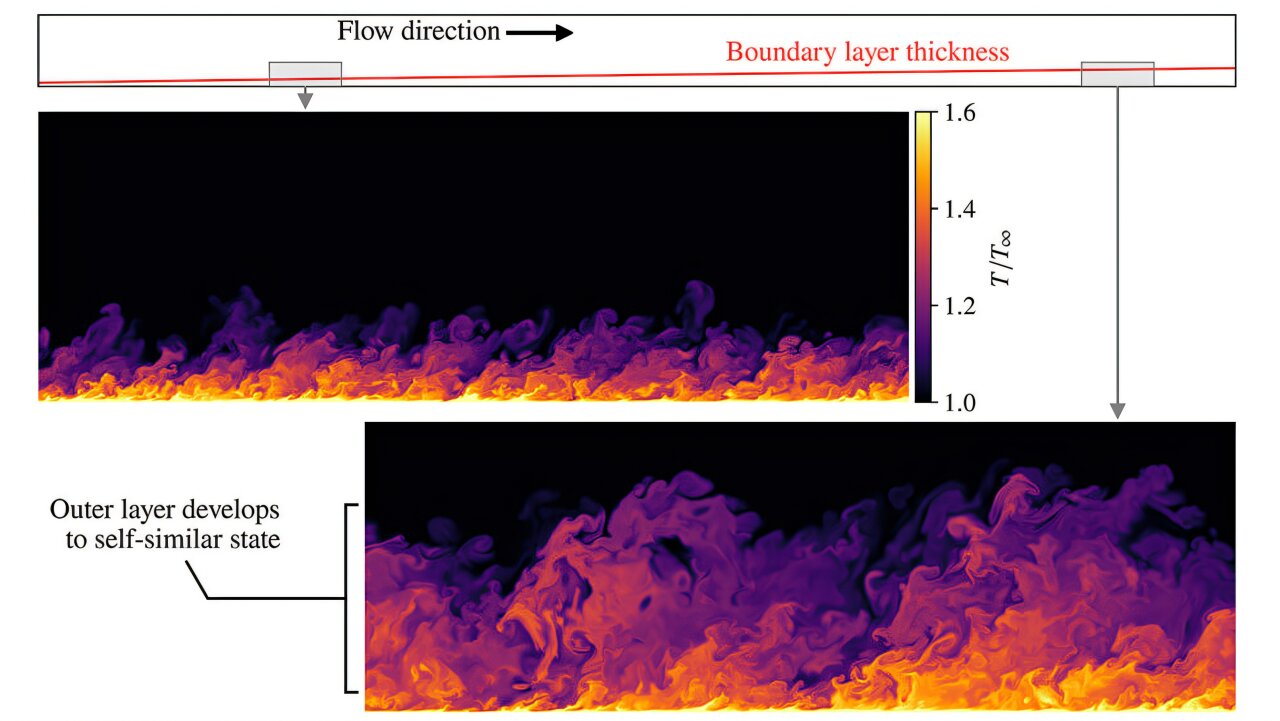Supercomputer Reveals Turbulent Boundary Layer Evolution at Moderate Reynolds Numbers

Advancements in Turbulence Modeling Through High-Performance Computing
Scientists at the University of Stuttgart's Institute of Aerodynamics and Gas Dynamics (IAG) have developed a groundbreaking dataset that promises to enhance the creation of turbulence models. Using the Hawk supercomputer at the High-Performance Computing Center Stuttgart (HLRS), researchers led by Dr. Christoph Wenzel conducted an extensive direct numerical simulation of a spatially evolving turbulent boundary layer. This research has yielded valuable insights into the behavior of turbulence, particularly as it transitions from early stages to fully developed states.
The simulation, which utilized over 100 million CPU hours on the Hawk system, is notable for capturing the onset of a canonical, fully-developed turbulent state within a single computational domain. One of the key findings was the identification of an inflection point where the outer region of the turbulent boundary layer begins to maintain a self-similar structure as it approaches high Reynolds numbers. These results are detailed in a recent paper published in the Journal of Fluid Mechanics.
"Our team's goal is to understand unexplored parameter regimes in turbulent boundary layers," said Jason Appelbaum, a Ph.D. candidate in the Wenzel Lab and leader of this research. "By running a large-scale simulation that fully resolves the entire development of turbulence from an early to an evolved state, we have generated the first reliable, full-resolution dataset for investigating how high-Reynolds-number effects emerge."
Challenges in Studying Moderate Reynolds Numbers
Turbulence plays a significant role in flight dynamics, contributing to high shear stress on aircraft surfaces and affecting fuel efficiency and performance. Aerospace engineers rely on computational models of the turbulent boundary layer, a thin region where the aircraft interacts with air flow. However, these models do not need to replicate every detail of the physics; they must be accurate enough for practical use while being computationally efficient.
To develop such models, scientific research using high-performance computing systems is essential. The Wenzel Lab has long used HLRS's supercomputers to run NS3D, a direct numerical simulation software designed to investigate the fundamental properties of turbulent boundary layers at extremely high resolution.
In computational fluid dynamics (CFD), the Reynolds number is a critical figure used to characterize the developmental state of a turbulent boundary layer. It represents the ratio of inertial forces to viscous forces in a fluid flow, governing the range of turbulent eddy sizes. At low Reynolds numbers, nonlinear convective instabilities responsible for turbulence are quickly damped by viscosity. As the Reynolds number increases, the turbulent boundary layer becomes thicker, and large coherent structures emerge, creating a more complex system with distinct properties.
Historically, CFD simulations have provided rich datasets for understanding turbulence at low Reynolds numbers. However, laboratory experiments have primarily focused on high Reynolds numbers due to physical limitations in sensor size and measurement accuracy. As a result, there has been a gap in understanding what happens between low and high Reynolds numbers.
A Breakthrough in Simulation
Appelbaum and his team addressed this gap by conducting a series of simulations on the Hawk supercomputer that replicated the entire evolution of a turbulent boundary layer from low to high Reynolds numbers. Despite the seemingly small scale of the real-life scenario—traveling at Mach 2 for approximately 20 milliseconds—the project required substantial computational resources.
The team used 1,024 computing nodes (over 130,000 cores) on Hawk, one-fourth of the machine, for hundreds of short runs lasting 4 to 5 hours each. The total runtime exceeded 30 days, making this one of the most extensive simulations of its kind.
"This investment paid off," Appelbaum said. "Our results reveal a sharp turn in the data, showing how previously separate datasets for low and high Reynolds numbers blend together."
One of the key parameters studied was the skin friction coefficient, which represents the proportion between shear stress at a solid surface and free momentum of the flow. The team found that the change in skin friction scaling is linked to the establishment of a fully-developed state in the outer 90% of the boundary layer. This self-similar state marks a milestone in the development of the turbulent boundary layer, signaling predictable scaling behavior as it evolves to industrially relevant Reynolds numbers.
Future Implications and Research Directions
This new dataset offers a unique resource for researchers in the computational fluid dynamics community. For the Wenzel Lab, the next step is to explore the physics behind the identified inflection point. Appelbaum plans to publish a follow-up paper soon, building on the work of Tobias Gibis, who recently defended his thesis on the scaling behavior of heat transfer and pressure gradients in turbulent boundary layers.
In other ongoing efforts, the lab is porting the NS3D code to GPUs on HLRS's newest supercomputer, Hunter. With support from AMD and HLRS staff, the team has verified that the code remains physically accurate and performant on the GPU-accelerated system. Future optimization will ensure the code takes full advantage of Hunter's increased performance.
"More computing power will allow us to simulate larger domains at even higher turbulent states," Appelbaum said. "It will also make it more feasible to conduct studies involving multiple parameters simultaneously."
The team's dataset at moderate Reynolds numbers will contribute to a growing pool of wall-bounded turbulent flow data, aiding in the development of more accurate turbulence models. This will enable engineers to optimize aircraft designs for a wider range of operating conditions and improve the efficiency of machines like fans and automobiles that rely on managing turbulent boundary layer effects.